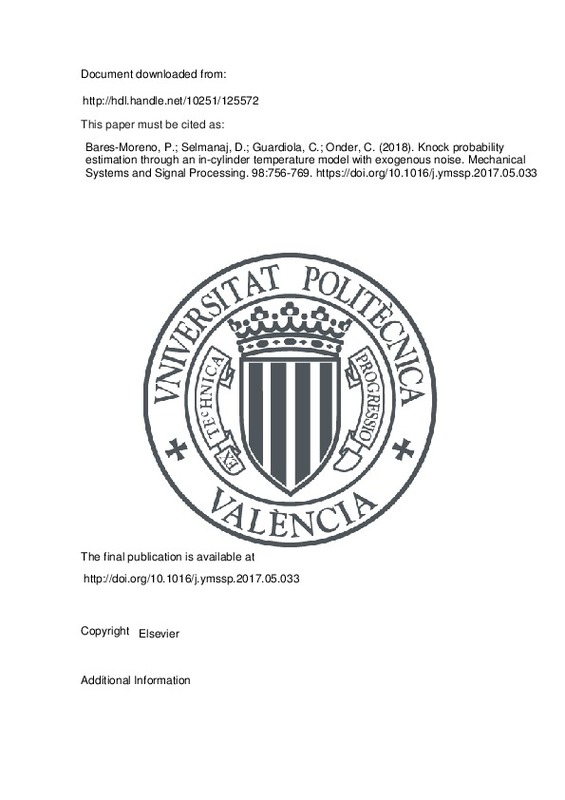JavaScript is disabled for your browser. Some features of this site may not work without it.
Buscar en RiuNet
Listar
Mi cuenta
Estadísticas
Ayuda RiuNet
Admin. UPV
Knock probability estimation through an in-cylinder temperature model with exogenous noise
Mostrar el registro sencillo del ítem
Ficheros en el ítem
| dc.contributor.author | Bares-Moreno, Pau
|
es_ES |
| dc.contributor.author | Selmanaj, D
|
es_ES |
| dc.contributor.author | Guardiola, Carlos
|
es_ES |
| dc.contributor.author | Onder, C
|
es_ES |
| dc.date.accessioned | 2019-09-11T20:01:05Z | |
| dc.date.available | 2019-09-11T20:01:05Z | |
| dc.date.issued | 2018 | es_ES |
| dc.identifier.issn | 0888-3270 | es_ES |
| dc.identifier.uri | http://hdl.handle.net/10251/125572 | |
| dc.description.abstract | [EN] This paper presents a new knock model which combines a deterministic knock model based on the in-cylinder temperature and an exogenous noise disturbing this temperature. The autoignition of the end-gas is modelled by an Arrhenius-like function and the knock probability is estimated by propagating a virtual error probability distribution. Results show that the random nature of knock can be explained by uncertainties at the in cylinder temperature estimation. The model only has one parameter for calibration and thus can be easily adapted online. In order to reduce the measurement uncertainties associated with the air mass flow sensor, the trapped mass is derived from the in-cylinder pressure resonance, which improves the knock probability estimation and reduces the number of sensors needed for the model. A four stroke SI engine was used for model validation. By varying the intake temperature, the engine speed, the injected fuel mass, and the spark advance, specific tests were conducted, which furnished data with various knock intensities and probabilities. The new model is able to predict the knock probability within a sufficient range at various operating conditions. The trapped mass obtained by the acoustical model was compared in steady conditions by using a fuel balance and a lambda sensor and differences below 1% were found. (C) 2017 Elsevier Ltd. All rights reserved. | es_ES |
| dc.language | Inglés | es_ES |
| dc.publisher | Elsevier | es_ES |
| dc.relation.ispartof | Mechanical Systems and Signal Processing | es_ES |
| dc.rights | Reconocimiento - No comercial - Sin obra derivada (by-nc-nd) | es_ES |
| dc.subject | Knock | es_ES |
| dc.subject | SI engines | es_ES |
| dc.subject | STFT | es_ES |
| dc.subject | Resonance | es_ES |
| dc.subject | Control | es_ES |
| dc.subject.classification | MAQUINAS Y MOTORES TERMICOS | es_ES |
| dc.subject.classification | INGENIERIA AEROESPACIAL | es_ES |
| dc.title | Knock probability estimation through an in-cylinder temperature model with exogenous noise | es_ES |
| dc.type | Artículo | es_ES |
| dc.identifier.doi | 10.1016/j.ymssp.2017.05.033 | es_ES |
| dc.rights.accessRights | Abierto | es_ES |
| dc.contributor.affiliation | Universitat Politècnica de València. Departamento de Máquinas y Motores Térmicos - Departament de Màquines i Motors Tèrmics | es_ES |
| dc.description.bibliographicCitation | Bares-Moreno, P.; Selmanaj, D.; Guardiola, C.; Onder, C. (2018). Knock probability estimation through an in-cylinder temperature model with exogenous noise. Mechanical Systems and Signal Processing. 98:756-769. https://doi.org/10.1016/j.ymssp.2017.05.033 | es_ES |
| dc.description.accrualMethod | S | es_ES |
| dc.relation.publisherversion | http://doi.org/10.1016/j.ymssp.2017.05.033 | es_ES |
| dc.description.upvformatpinicio | 756 | es_ES |
| dc.description.upvformatpfin | 769 | es_ES |
| dc.type.version | info:eu-repo/semantics/publishedVersion | es_ES |
| dc.description.volume | 98 | es_ES |
| dc.relation.pasarela | S\374241 | es_ES |







![[Cerrado]](/themes/UPV/images/candado.png)

